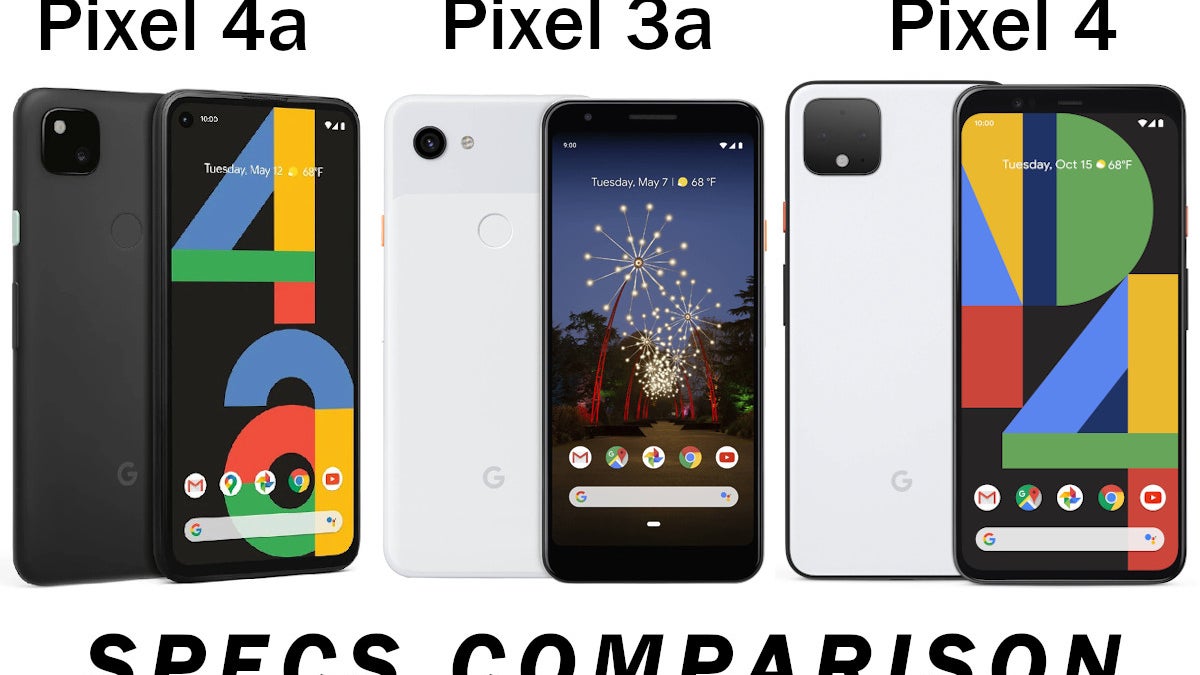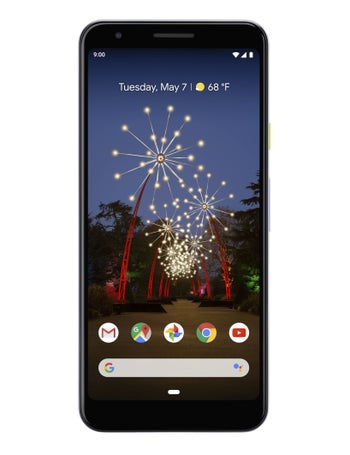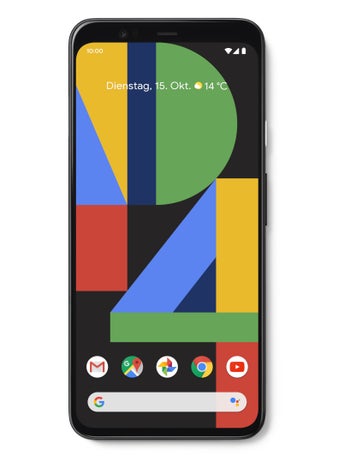Google Pixel 4a vs Pixel 3a vs Pixel 4: design and specs comparison
We may earn a commission if you make a purchase from the links on this page.

The long-awaited Pixel 4a is finally here, Google's second budget Pixel device. Unlike last year's two models, the Pixel 3a and 3a XL, this year Google went with a single model with a display size that fits between the previous two.
So, how does Google's latest creation compare to its previous two? Well, that's what we're here to find out!
Google Pixel 4a vs Pixel 3a vs Pixel 4 design comparison
As you can see above, there's not that much to discuss in this section as Google is keeping to its design philosophy with the Pixel 4a. On the back, the phone is a mix between the 3a's plastic body and fingerprint reader and the Pixel 4's square camera bump. Unlike the Pixel 4, however, the 4a has a single rear camera, but more about that later.
The biggest difference between the Pixel 4a and the other two phones is at the front. Gone are the thick bezels, replaced with a small hole-punch in the upper-left corner instead. It's a look fitting for 2020, which is preferable over another Google design experiment (like the Pixel 3 XL).
We're also happy to notice the return of the headphone jack. Of course, it will go missing again once the Pixel 5 is released, but at least Google kept it on its budget device, unlike some other manufacturers (looking at you, OnePlus!).
Overall, the simplistic design of the Pixel 4a may lack the fancy colors other budget phones try to lure you with, but it looks fit perfectly to its purpose: to be the bread and butter Android phone.
Google Pixel 4a vs Pixel 3a vs Pixel 4 specs comparison
But while looks are important for some people, others care more about what's inside. And when it comes to smartphones, the specs are what will influence your experience the most. So, let's compare what these three Pixels are packing.
|
|
|
|
| Google Pixel 4a | Google Pixel 3a | Google Pixel 4 |
| Size | ||
|---|---|---|
| 5.8-inch, 82.53% screen-to-body | 5.6-inch, 73.93% screen-to-body | 5.7-inch, 77.32% screen-to-body |
| Type | ||
| OLED, 60Hz, HDR | OLED | OLED, 90Hz, HDR |
| Resolution | ||
| 2340x1080px, 19.5:9 ratio, 444 PPI | 2220x1080px, 18.5:9 ratio, 444 PPI | 2280x1080px, 19:9 ratio, 443 PPI |
| Protection | ||
| Corning Gorilla Glass 3 | Dragontrail | Corning Gorilla Glass 5 |
| System chip | ||
|---|---|---|
| Snapdragon 730G SM7150-AA (8 nm) | Snapdragon 670 SDM670 (10 nm) | Snapdragon 855 SM8150 (7 nm) |
| Processor | ||
| Octa-core 2200 MHz Kryo 470 |
Octa-core 2000 MHz Kryo 360 |
Octa-core Kryo 485 |
| GPU | ||
| Adreno 618 | Adreno 615 | Adreno 640 |
| Memory | ||
| 6GB (LPDDR4)/128GB (UFS 2.1) | 4GB (LPDDR4)/64GB (eMMC) | 6GB (LPDDR4)/64GB 6GB/128GB |
| Storage expansion | ||
| not expandable | not expandable | not expandable |
| OS | ||
| Android (12, 11, 10) | Android (12, 11, 10, 9.0 Pie) | Android (12, 11, 10) |
| Type | ||
|---|---|---|
| 3140 mAh, Li - Polymer | 3000 mAh | 2800 mAh |
| Charging | ||
| USB Power Delivery | USB Power Delivery | USB Power Delivery Qi wireless charging |
| Charge speed | ||
| Wired: 18.0W | ||
| Rear | ||
|---|---|---|
| Single camera | Single camera | Dual camera |
| Main camera | ||
| 12.2 MP (OIS, PDAF) Aperture size: F1.7 Focal length: 27 mm Sensor size: 1/2.55" Pixel size: 1.4 μm | 12.2 MP (OIS, PDAF) Aperture size: F1.8 Focal length: 28 mm Sensor size: 1/2.55" Pixel size: 1.4 μm | 12.2 MP (OIS, PDAF) Aperture size: F1.7 Focal length: 28 mm Sensor size: 1/2.55" Pixel size: 1.4 μm |
| Second camera | ||
| 16 MP (Telephoto, OIS, PDAF) Aperture size: F2.4 Focal Length: 45 mm Pixel size: 1 μm |
||
| Flash | ||
| LED | Dual LED | Dual LED |
| Video recording | ||
| 4K UHD (30 fps), 1080p (120 fps), 720p (240 fps) EIS | 4K UHD (30 fps), 1080p (120 fps), 720p (240 fps) EIS | 4K UHD (30 fps), 1080p (120 fps), 720p (240 fps) OIS, Time-lapse video, EIS |
| Front | ||
| 8 MP Video capture: 1080p | 8 MP Video capture: 1080p | 8 MP (Dual-Camera, Time-of-Flight (ToF)) Video capture: 1080p |
| Bluetooth | ||
|---|---|---|
| 5.1 | 5.0 | 5.0 |
| WLAN | ||
| a,b,g,n,ac,dual-band MIMO, Wi-Fi Direct, Hotspot 802.11 a, b, g, n, ac | a,b,g,n,ac,dual-band MIMO, Wi-Fi Direct, Hotspot 802.11 a, b, g, n, ac | a,b,g,n,ac,dual-band MIMO, Wi-Fi Direct, Hotspot 802.11 a, b, g, n, ac |
| USB | ||
| Type-C, USB 3.1 | Type-C, USB 2.0 | Type-C, USB 3.1 |
| Sensors | ||
| Accelerometer, Gyroscope, Compass, Barometer, Ambient light sensor, Proximity sensor | Accelerometer, Gyroscope, Compass, Barometer, Ambient light sensor, Proximity sensor | Accelerometer, Gyroscope, Compass, Barometer, Ambient light sensor, Proximity sensor |
| Hearing aid compatible | ||
| M3/T4 | M3/T3 | M3/T3 |
| Location | ||
| GPS, A-GPS, Glonass, Galileo, Cell ID, Wi-Fi positioning | GPS, A-GPS, Glonass, Galileo, Cell ID, Wi-Fi positioning | GPS, A-GPS, Glonass, Galileo, Cell ID, Wi-Fi positioning |
| Other | ||
| NFC | NFC, VoIP, Tethering, Computer sync, OTA sync | NFC |
See the full
Google Pixel 4a vs Google Pixel 3a vs Google Pixel 4 specs comparison
or compare them to other phones using our
Phone Comparison tool
Compared to its predecessor, the Pixel 3a, the 4a brings significant improvements in three major catogries: SoC, memory and storage.
Starting with the chips, this year, Google went for a 700-series Qualcomm chip, instead of a 600-series one, which is great news. You might be surprised it's not the Snapdragon 765G, but there's a good reason for that. Rumors around the Pixel 5 state that Google is moving away from the flagship 800-series chips this year and will instead go for the 765G just like LG did with the new Velvet.
The extra 2GB of RAM are a good addition as well, but most importantly, the base storage on the Pixel 4a is 128GB, twice the amount you're getting with the much more expensive Pixel 4.
Unlike many other budget phones these days that boast quad-camera setups that often lack quality, the Pixel 4a is fitted with a single camera that has the same sensor as last year's Pixel 4. Paired with Google's camera software, the 4a should take best-in-class pictures and even better than some flagship phones from other brands. The lack of a telephoto camera is unfortunate, but we'd take an awesome single camera over two mediocre ones any day.
The Pixel 4a comes with the biggest battery among the three, unfortunately, that's not high praise. At 3,140mAh, the battery capacity is far from what we're now used to seeing on Android phones, where 4,000mAh is almost a given.
All in all, the Pixel 4a stacks favorably against its predecessor in every way, as it should be. Add to that software support that will surely outlast that of similarly priced Android phones and you have a device that's perfect for users that aren't hell-bent on having a high-end smartphone.
Follow us on Google News

















Things that are NOT allowed:
To help keep our community safe and free from spam, we apply temporary limits to newly created accounts: